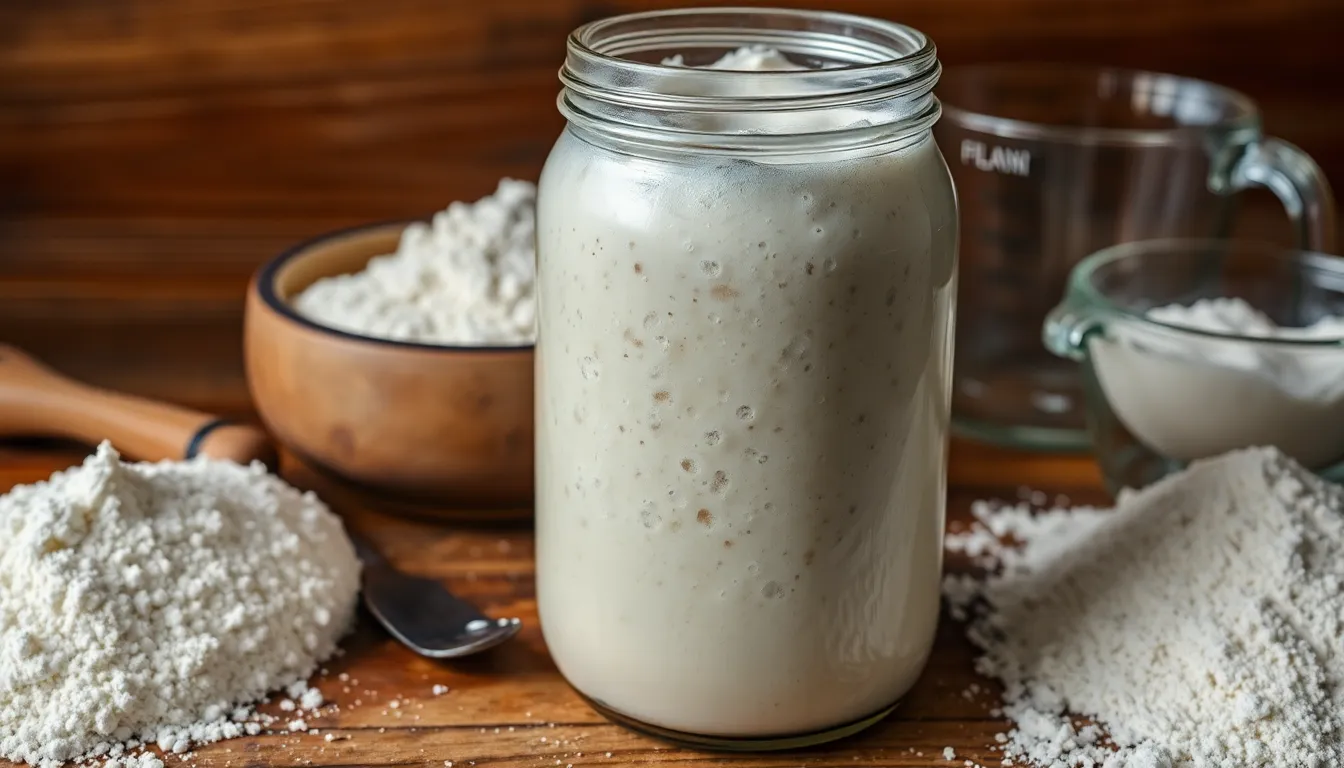Sourdough bread has taken the culinary world by storm, but many wonder if it really contains yeast. Picture this: a crusty loaf, its aroma wafting through the air, making your taste buds dance in anticipation. But wait—what’s the secret behind this beloved bread?
While sourdough doesn’t rely on commercial yeast like its fluffy cousins, it’s not yeast-free either. Instead, it’s the wild yeast and bacteria from the environment that work their magic, creating that tangy flavor and delightful texture. So, does sourdough bread have yeast? The answer might just surprise you! Dive into the fascinating world of fermentation and discover why this ancient bread is a staple in kitchens everywhere.
Table of Contents
ToggleOverview of Sourdough Bread
Sourdough bread is distinct for its unique flavor and texture, resulting from a natural fermentation process. Wild yeast and lactic acid bacteria present in the environment play crucial roles in this method, enabling the bread to rise without the addition of commercial yeast. During fermentation, the wild yeast consumes sugars in the dough, producing carbon dioxide and contributing to the bread’s airy structure.
The fermentation process also leads to the development of lactic acid, which enhances the sour taste characteristic of sourdough. The natural fermentation takes longer than traditional methods, often spanning several hours or even days. This extended time allows for complex flavors to develop, making sourdough an appealing choice for many bakers.
Sourdough’s popularity has surged recently due to its health benefits and artisanal qualities. Many consider it easier to digest than bread made with commercial yeast. The combination of beneficial bacteria and fermentation techniques contributes to better nutrient absorption, which may support gut health.
Homemade sourdough offers a delightful cooking experience. Bakers can cultivate their starter, a mixture of flour and water, fostering wild yeast. Maintaining the starter can become a rewarding routine, connecting bakers to the age-old traditions of bread-making.
Sourdough can be paired with various dishes, from sandwiches to soups. It complements an array of flavors, making it versatile in both casual and gourmet meals. Its unique properties and flavor profile showcase why sourdough continues to be a beloved choice for bread enthusiasts worldwide.
The Fermentation Process

Sourdough’s fermentation process is essential for its distinct flavor and texture. This natural process involves wild yeast and bacteria, transforming the simple ingredients of flour and water into a beloved bread.
Role of Wild Yeast
Wild yeast plays a crucial role in creating sourdough’s airy structure. It naturally resides in the environment and in the sourdough starter, allowing fermentation to occur without the addition of commercial yeast. As the wild yeast consumes sugars in the dough, it produces carbon dioxide bubbles that make the bread rise. Flour types also influence wild yeast activity; for instance, whole grain flours typically harbor more yeast than refined counterparts. The fermentation time allows flavors to intensify, resulting in a more complex profile.
Role of Bacteria
Bacteria, particularly lactic acid bacteria, are vital in developing sourdough’s signature tang. These beneficial microorganisms thrive alongside wild yeast in the starter. They generate organic acids, which enhance the bread’s flavor and act as natural preservatives. Increased acidity not only contributes to taste but also improves the bread’s digestibility. The interaction between wild yeast and bacteria creates a harmonious balance, ensuring a moist crumb and golden crust. Varieties of lactic acid bacteria vary in different sourdough cultures, leading to diverse flavor profiles.
Comparison with Commercial Bread
Sourdough bread and commercial bread differ significantly in their ingredient composition and fermentation processes.
Presence of Added Yeast
Commercial breads often contain added yeast for a quicker fermentation process. These yeasts are typically cultivated for consistency and reliability. Sourdough, on the other hand, relies on naturally occurring wild yeast sourced from the environment. This microbial diversity contributes to sourdough’s rich flavor profile, whereas commercial yeast simplifies the process but lacks complexity. Commercial bread’s faster rise results in less time for flavor development, with added preservatives also common to extend shelf life. Many artisanal bakers prefer the natural fermentation of sourdough, valuing its unique character over speed.
Flavor and Texture Differences
Distinct flavors characterize sourdough and commercial bread. The long fermentation of sourdough allows for the development of rich, tangy notes that enhance its complexity. In contrast, commercial bread often tastes bland due to the rapid fermentation method. Texture also varies greatly; sourdough typically features a chewy crust and a moist crumb that comes from the slow rise and hydration of the dough. Commercial bread, conversely, can be soft and airy but often lacks the depth of mouthfeel seen in sourdough. This difference in textures and flavors makes sourdough a favorite among those appreciating artisanal qualities in their bread.
Health Benefits of Sourdough Bread
Sourdough bread provides multiple health benefits, making it a popular choice among health-conscious individuals. Enhanced digestibility ranks high among these benefits, as the fermentation process breaks down gluten and complex carbohydrates. Many people who struggle with traditional bread find sourdough easier on their digestive systems.
Nutrient absorption also improves with sourdough bread. The fermentation lowers phytate levels, which inhibit mineral absorption. This allows minerals like iron, magnesium, and zinc to become more bioavailable, supporting overall health.
Lower glycemic index readings characterize sourdough. Studies indicate that sourdough bread can help stabilize blood sugar levels, reducing spikes after meals compared to conventional bread. This makes sourdough a better option for those managing diabetes or looking to maintain steady energy levels throughout the day.
In addition, sourdough contains beneficial bacteria that may promote gut health. Probiotics survive through the baking process, contributing to a balanced gut microbiome. This can enhance digestion and boost the immune system, providing an added layer of wellness.
Sourdough also features unique flavor profiles that attract aficionados. Different fermentation times and starter cultures can yield a variety of tastes, allowing each loaf to be a unique culinary experience. Choosing sourdough not only satisfies taste buds but also aligns with healthier eating habits.
Lastly, sourdough bread serves as a healthier alternative to commercial bread options, which often contain preservatives and added sugars. Emphasizing natural ingredients, sourdough bread fits into a whole-foods diet, contributing to long-term health benefits.
Sourdough bread stands out not just for its flavor but also for its unique fermentation process. The absence of commercial yeast means it relies on wild yeast and bacteria, which create a depth of flavor and texture that’s hard to replicate. This natural method not only enhances taste but also offers various health benefits, making sourdough a favorite among many.
As more people embrace artisanal baking and healthier eating habits, sourdough’s appeal continues to grow. Its versatility and rich history connect bakers to traditions while providing a nutritious option for those seeking better alternatives to commercial bread. Embracing sourdough is more than just a culinary choice; it’s a journey into the art of bread-making and the joy of wholesome ingredients.





